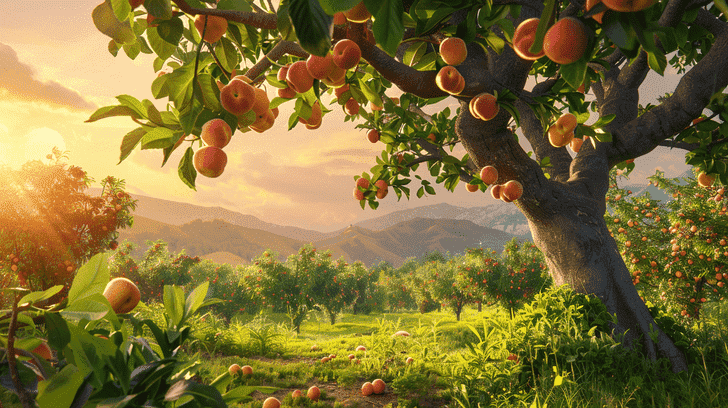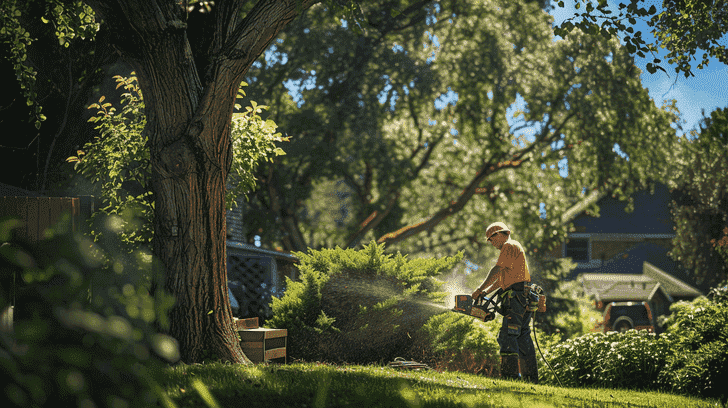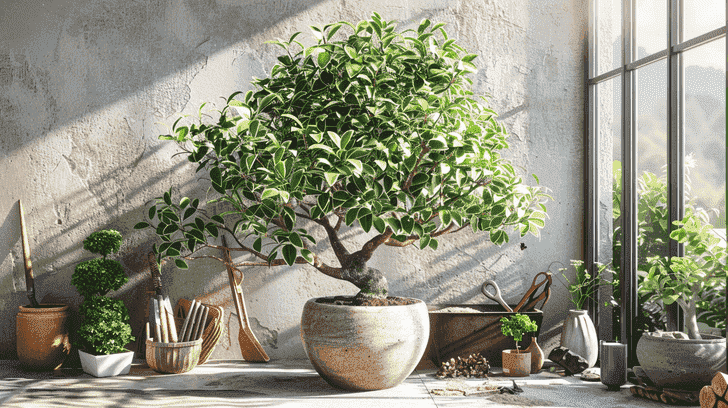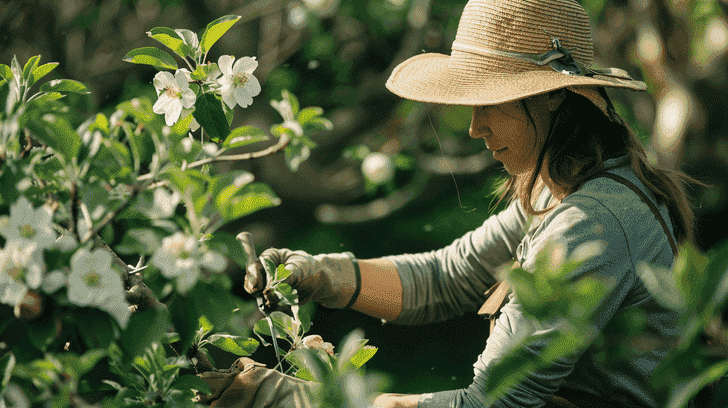Peach Tree Trimming – Tips for a Bountiful Harvest
You’re about to drastically improve the health, productivity, and fruit quality of your peach tree, as proper trimming techniques can enhance fruit production by up to 50%.
To achieve this, you’ll need to prune your tree annually, removing diseased or broken branches, maintaining an open center, and pruning shoots towards the center.
You’ll also need to maintain 45-degree branch angles and cut back long fruiting wood.
By doing so, you’ll facilitate air and light circulation, maximize fruit production, and set your tree up for long-term success.
Next, discover how to enhance your pruning techniques to reveal your peach tree’s full potential.
Importance of Peach Tree Pruning
Trimming your peach tree is vital for its overall health, productivity, and fruit quality, as it sets the tree up for long-term success and helps you reap a bountiful harvest.
Proper pruning leads to a healthy, productive tree that bears large, healthy fruit and is less susceptible to disease.
It facilitates air and light circulation within the tree, maximizing fruit production and tree health.
Pruning Techniques for Productivity
To prune your peach tree for best productivity, start by removing any diseased or broken branches, as these can hinder the tree’s ability to produce healthy fruit and compromise its overall health.
Next, maintain the open center by removing vigorous upright shoots, which will improve air and light circulation within the tree. Prune shoots towards the center to further enhance circulation.
To promote strong branches, maintain 45-degree branch angles and cut back long fruiting wood to strengthen them.
Key Differences From Apple Trees
You’ll find that pruning peach trees differs considerably from pruning apple trees, primarily due to their distinct growth patterns and fruiting habits.
Peach trees require heavy pruning due to their vigorous growth, whereas apple trees don’t need as much pruning.
When pruning peach trees, you’ll need to remove about 40% of new growth to promote renewal, whereas apple trees may respond to heavy pruning by producing excessive shoot and leaf growth.
Additionally, peach trees produce fruit on one-year-old wood, whereas apple trees produce fruit on older wood.
Understanding these key differences is essential for effective pruning and maximizing fruit production in peach trees.
Controlling Peach Tree Size
As you prune your peach tree to promote healthy growth and fruit production, managing its size and height becomes a critical aspect of maintaining a productive and easily manageable tree.
When you prune a peach tree, you need to regulate its size to make sure it remains accessible for maintenance and harvesting.
To achieve this, prune upright branches to encourage side branches at a 45-degree angle. This will promote a more compact tree structure.
For tree height control, prune tall branches to maintain a manageable height, making it easier to care for your tree.
By controlling the size of your peach tree, you’ll reduce the effort required for maintenance, while also facilitating easier spraying and fruit harvesting.
Additionally, proper pruning sets the stage for effective fruit thinning, which is essential for promoting fruit quality and maturity.
Managing Fruit Production Cycles
Every year, your peach tree’s fruit production cycle follows a predictable pattern, with flowers blooming, fruit setting, and ripening at specific times, making it essential to manage these cycles to optimize fruit quality and yield.
By pruning peach trees annually, you can control the fruit production cycle, allowing for better fruit quality and yield.
Fruit thinning is also vital in managing the cycle, as it prevents overcrowding and promotes healthy fruit development.
Proper pruning and thinning techniques will help you achieve a well-balanced fruit production cycle, resulting in high-quality peaches.
Benefits of Fruit Thinning Practices
By implementing fruit thinning practices, you can greatly reduce the risk of over-bearing, which can lead to fruit drop, reduced fruit size, and decreased fruit quality.
As a peach tree grower, you want to guarantee that your trees produce high-quality fruit.
Fruit thinning helps achieve this by allowing the remaining fruit to grow larger and more evenly. This, in turn, improves fruit quality and increases the chances of successful fruit development.
By thinning the fruit, you’re also reducing the risk of disease and pest issues, as overcrowding can create an environment conducive to these problems.
Timing and Frequency of Pruning
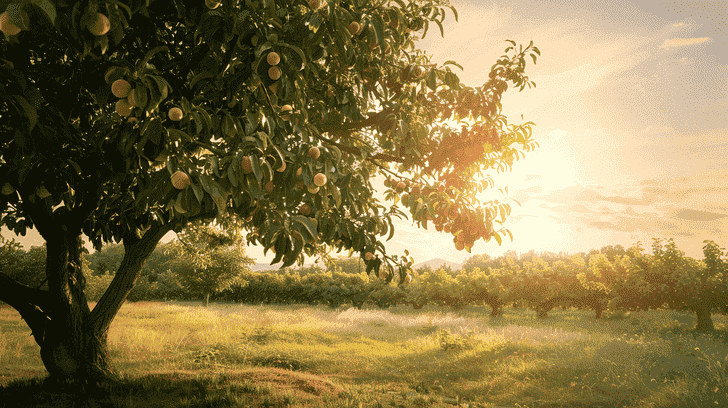
To prune your peach trees effectively, you’ll need to prune them at the right time, since improper timing can lead to reduced fruiting or increased susceptibility to disease.
Pruning frequency is also important, as pruning too frequently can stress the tree, while pruning too infrequently can lead to reduced fruit production.
Here are some key considerations for timing and frequency of pruning:
- Dormant season pruning: Prune your peach trees during the dormant season (winter) to minimize disease risk and promote healthy growth.
- Annual pruning: Prune your peach trees annually to maintain their shape, promote fruiting, and remove diseased or damaged branches.
- Post-harvest pruning: Prune your peach trees after harvest to promote new growth and prepare the tree for the next growing season.
- Pruning frequency: Prune your peach trees every 1-2 years, depending on the tree’s growth rate and fruit production.
Common Mistakes to Avoid
When pruning your peach trees, avoiding common mistakes is crucial to maintaining their health and productivity.
One common mistake to avoid isn’t pruning your peach tree at all. This can lead to reduced fruit production and increased disease susceptibility.
Another mistake is over-pruning, which can stress the tree and reduce fruiting.
Avoid pruning your peach tree during the active growing season, as this can cause new growth that’s susceptible to disease.
Additionally, don’t prune your peach tree without a clear understanding of proper pruning techniques. Improper pruning can damage the tree and reduce fruit production.
FAQ
What month do you prune peach trees?
Typically, you prune peach trees in late winter or early spring, February or March in the Northern Hemisphere, before new growth begins.
This allows you to prune when the tree is dormant, making it easier to see the branch structure and make precise cuts.
Pruning at the right time also helps promote healthy growth and fruit production.
Here are some key considerations when deciding when to prune your peach tree:
- Avoid pruning in the fall: This can stimulate new growth that may not have time to harden off before winter.
- Prune before new growth begins: Pruning too late can remove new growth and reduce fruit production.
- Prune during the dormant season: This helps prevent pruning wounds from getting infected.
- Check your local climate: If you live in a region with a shorter winter, you may need to adjust your pruning schedule accordingly.
What happens if you don’t prune a peach tree?
If you neglect to prune your peach tree, it can lead to a multitude of problems that negatively impact its health, productivity, and overall structure.
Without regular pruning, your tree will become overcrowded, reducing air circulation and increasing the risk of disease.
Fungal diseases, such as powdery mildew, can spread quickly through the tree, causing damage and reducing fruit production.
Unpruned peach trees also produce fewer, smaller fruits, and may even stop producing fruit altogether.
Neglecting pruning can also lead to weak branch structures, making them prone to breakage. By not pruning your peach tree, you’re ultimately setting it up for failure.
Regular pruning is essential to maintain a healthy, productive tree that produces high-quality fruit.
What is the best time to prune fruit trees?
When you prune your peach tree at the right time, you’re giving it the best chance to thrive, but determining that ideal pruning window can be tricky, especially considering the varying growth patterns and climates.
The best time to prune fruit trees depends on factors like climate, tree age, and growth patterns. Here are some guidelines to keep in mind:
- Dormant season: Prune fruit trees during their dormant season, usually from late winter to early spring, to minimize sap flow and reduce disease risk.
- After harvest: Prune fruit trees immediately after harvest to allow the tree to focus energy on new growth.
- Avoid active growth: Avoid pruning during active growth periods, as this can stress the tree and reduce fruit production.
- Regional considerations: Consider regional climate and growth patterns when determining the best pruning time for your fruit trees.
Can you cut a branch off a peach tree and replant it?
You can propagate a new peach tree by cutting a branch off an existing one, a process called budding or grafting, but it requires careful consideration and precise technique to guarantee success.
This method involves pruning a healthy, disease-free branch from a mature peach tree and replanting it in a new location.
The branch, known as a scion, is typically 1-2 years old and has at least two buds. It’s important to match the scion with a compatible rootstock and establish a secure graft union.
Proper pruning techniques are vital during the replanting process to promote healthy growth and prevent disease.
By following precise grafting methods, you can successfully replant a branch and grow a new, thriving peach tree.
Conclusion
You’ve mastered the art of pruning your peach trees like a pro! With these techniques, you’ll be swimming in a sea of juicy peaches in no time.
Remember, pruning isn’t a one-time task, but a yearly ritual to guarantee a bountiful harvest. By following these guidelines, you’ll be enjoying a peach-filled paradise in your backyard.

